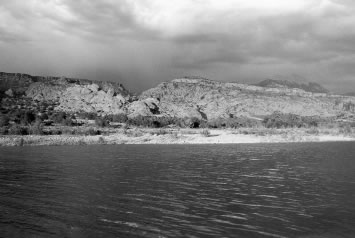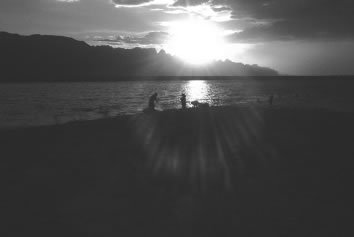Popular Ken's Lake
Reservoir
Has Served Moab Area Since 1981
by Jeff Richards
Twenty-two years ago, on June
5, 1981, Ken’s Lake was officially dedicated. The
$4 million reservoir construction project in upper Spanish
Valley, approximately 10 miles southeast of Moab, was completed
over a two-year period beginning in 1979.
The project was sponsored by the Grand County Water Conservancy
District, using funds borrowed from the Utah Division of
Water Resources loan fund. Local voters approved a bond
issue in October 1978 by a six-to-one margin, giving the
project the go-ahead financially.

Today, the Bureau of Land
Management oversees the management of the lake. Although
it is classified as a Day Use recreational area by the BLM,
there is overnight camping available in an adjacent 31-site
campground to the southeast of the lake.
The project had been known as the Mill Creek Dam project
prior to its dedication, but during the ceremony, the reservoir
was officially named Ken’s Lake (or K.E. McDougald
Reservoir) in honor of Ken McDougald, the water conservancy
district chairman who had labored for some 15 years to see
the project come to fruition.
McDougald, who had also served as the mayor of Moab during
the hectic uranium boom years, died just two years after
the Ken’s Lake dedication in an plane accident in
New Mexico on Nov. 18, 1983.
Excavation work was finished on the 95-foot high dam in
December 1980, using approximately 900,000 cubic yards of
earth fill. Over the years, the dam has developed a few
leaks requiring repairs. A few years ago, the lake was allowed
to drain almost completely so that large earth-moving machinery
could be used to make structural repairs to the dam. Following
that was 2002’s severe drought, which resulted in
the lake hardly being filled. In the late spring of 2003,
however, the lake reached its highest level in at least
five years. Ken’s Lake can hold around 2,750 acre
feet of water when full.

The reservoir itself was made possible by diverting Mill
Creek water into a 645-foot tunnel which had been started
decades earlier by pioneer Horace Sheley. Although Sheley
was never able to finish his ambitious project, Mill Creek
project construction crews continued boring through the
rock until they reached the western side of the sandstone
formation. To this day, water from Mill Creek flows through
a pipe and trickles down the rocks like a waterfall of sorts
until it enters the lake at the southeast corner.
The reservoir was designed to provide irrigation water for
some 492 acres of land in Spanish Valley. The upper Spanish
Valley area had long been known as Poverty Flats, partly
because of its notorious lack of water.
Some of the notable names who participated in the dedication
ceremony in 1981 were as follows: Moab Mayor Harold Jacobs;
Philip Knight, chairman of the Board of Water Resources;
Dan Lawrence, director of the Utah Division of Water Resources;
Ray Tibbetts, Grand County Commissioner; Clyde Conover,
member of the Board of Water Resources for Southeastern
Utah; and Gordon Harmston, executive director of the Utah
Department of Natural Resources. Sam Taylor, publisher of
the Times-Independent newspaper, served as the master of
ceremonies. The opening prayer was given by Pastor Wayne
Hoag of the Moab Christian Center, and the dedicatory prayer
was offered by Bishop Don Cook of the LDS Church.
Right from its beginning 22 years ago, Ken’s Lake
has seen moderate and consistent recreational use, with
anglers, swimmers, picnickers, canoeists, and kayakers sharing
the popular spot. There are no water-skiers or personal
watercraft users, though — gas powered motors are
not allowed on the lake.
The lake is stocked regularly with rainbow trout, which
can be fished from shore using marshmallows, salmon eggs,
or floating cheese bait. Some anglers fly-fish for brown
trout right where the stream enters the lake. Ken’s
Lake is also home to populations of largemouth bass, catfish,
bluegill, and perch. The Ken’s Lake area is also popular
with hikers, mountain bikers, and horseback riders.
A couple of years ago, the BLM constructed additional facilities,
including campsite improvements (picnic tables, tent spots,
fire pits, etc.), roads and parking places, signs, and more
restrooms. A $10 fee is charged for overnight camping, which
is limited to 14 days within a 30-day period. Trash receptacles
are available, but there is no running water or electricity.
Wood gathering and wood cutting are prohibited. Currently,
statewide fire restrictions are in effect, meaning that
no open fires are allowed. For more information, contact
the Moab BLM office, 259-2100 or visit the website www.ut.blm.gov.
 Moab
Historic Happenings August 2003
Moab
Historic Happenings August 2003
